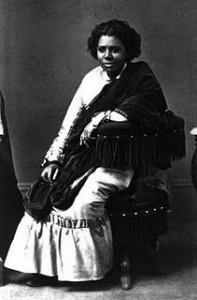Oberlin College, a Christian abolitionist college in Ohio, is in an uproar. A young African American student is accused of poisoning two white female students who were boarding in the same house as the accused.
Edmonia Lewis was born about 1844 in either New York, New Jersey or Ohio (the various accounts of her birth differ) of West Indies African and Chippewa heritage. According to some sources, she spent her early years wandering the wilderness with her mother’s Chippewa tribe prior to her brother accumulating the necessary finances to send her to school.
After she attended a local grammar school in New York, her brother Samuel enrolled Edmonia at New York Central College, a Baptist abolitionist secondary school in McGrawville, New York. Afterwards, in 1859, Samuel sent his sister to Oberlin College’s Young Ladies Preparatory Department, a school that had been founded by abolitionists in 1835. The first in the nation to admit women and African-Americans, Oberlin stood out as America’s first coeducational and interracial college. Attended by northern Christian students of many denominations, Oberlin reflected larger realities in the North. Abolitionist commitment, in essence, often served to blur denominational lines in the antebellum and Civil War era North.
Yet the events at Oberlin this month cause great unease between African Americans and whites.
Following the accusations of poisoning her fellow students, Edmonia, awaiting trial, is seized by a group of whites and beaten so viciously that she is confined to a bed for weeks.
When her day in court arrives, Edmonia is defended by John Mercer Langston, early abolitionist, Oberlin graduate, and the first African-American admitted to the Ohio bar. Langston had received his early education in an African Baptist church, and subsequently remained nominally involved in Baptist life.
Much to her relief, Edmonia is acquitted. Immediately following her acquittal, she is carried from the courtroom on the shoulders of (mostly white) friends. Returning to Oberlin, she resumes her studies.
In the years following, Edmonia develops her artistic talents and becomes America’s first famous black sculpture, gaining international fame. She becomes friends with Frederick Douglass and travels throughout the world.
Meanwhile, her brother Samuel in 1868 settles in the new frontier town of Bozeman, Montana. There he becomes a prominent citizen, owning a barber shop and rental houses.
For his part, John Mercer Langston becomes the first dean of the law school at Howard University and the first president of Virginia State University. He also becomes active in politics. In 1888 he is elected to the U.S. Congress, the first African American from Virginia to achieve such distinction, and the only one for nearly a century.
Sources: “Edmonia Lewis” (link) and (link); “History of Oberlin” (link); William F. and Aimee Lee Cheek, John Mercer Langston and the Fight for Black Freedom, 1829-1865. University of Illinois, 1966 (link); photograph (link)



